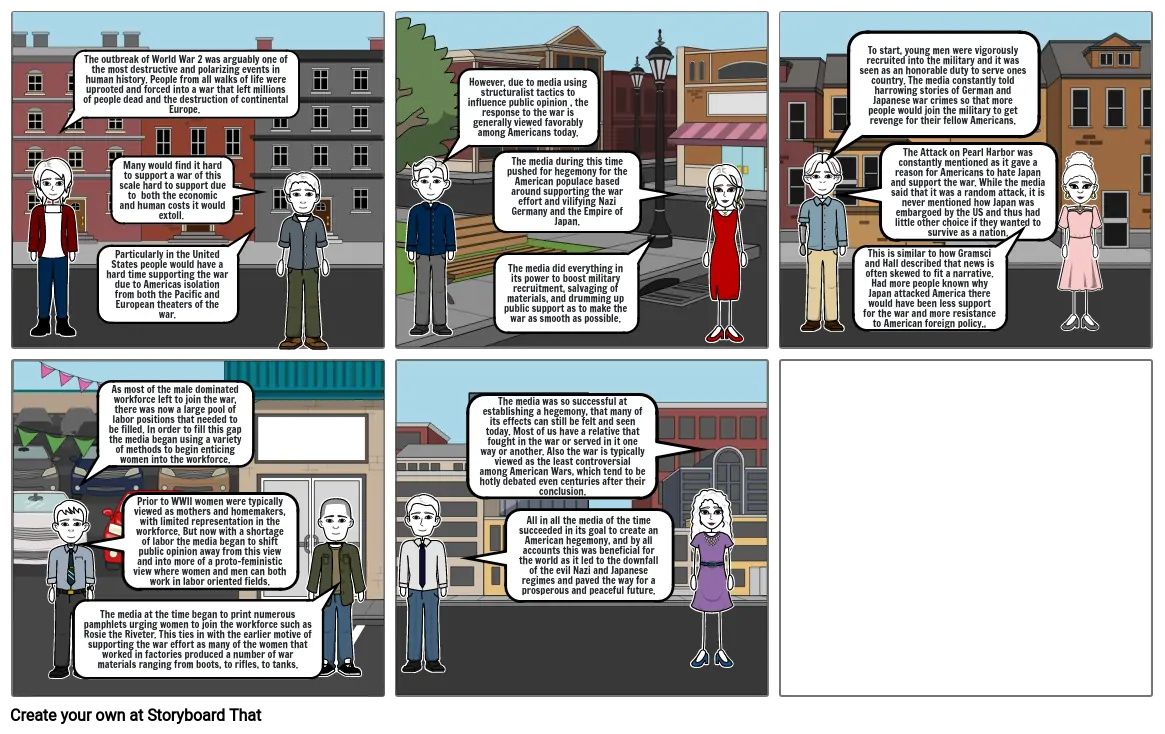Structuralism during WWII

Storyboard Text
- The outbreak of World War 2 was arguably one of the most destructive and polarizing events in human history. People from all walks of life were uprooted and forced into a war that left millions of people dead and the destruction of continental Europe.
- Particularly in the United States people would have a hard time supporting the war due to Americas isolation from both the Pacific and European theaters of the war.
- Many would find it hard to support a war of this scale hard to support due to both the economic and human costs it would extoll.
- However, due to media using structuralist tactics to influence public opinion , the response to the war is generally viewed favorably among Americans today.
- The media did everything in its power to boost military recruitment, salvaging of materials, and drumming up public support as to make the war as smooth as possible.
- The media during this time pushed for hegemony for the American populace based around supporting the war effort and vilifying Nazi Germany and the Empire of Japan.
- To start, young men were vigorously recruited into the military and it was seen as an honorable duty to serve ones country. The media constantly told harrowing stories of German and Japanese war crimes so that more people would join the military to get revenge for their fellow Americans.
- The Attack on Pearl Harbor was constantly mentioned as it gave a reason for Americans to hate Japan and support the war. While the media said that it was a random attack, it is never mentioned how Japan was embargoed by the US and thus had little other choice if they wanted to survive as a nation.
- This is similar to how Gramsci and Hall described that news is often skewed to fit a narrative. Had more people known why Japan attacked America there would have been less support for the war and more resistance to American foreign policy.,
- The media at the time began to print numerous pamphlets urging women to join the workforce such as Rosie the Riveter. This ties in with the earlier motive of supporting the war effort as many of the women that worked in factories produced a number of war materials ranging from boots, to rifles, to tanks.
- Prior to WWII women were typically viewed as mothers and homemakers, with limited representation in the workforce. But now with a shortage of labor the media began to shift public opinion away from this view and into more of a proto-feministic view where women and men can both work in labor oriented fields.
- As most of the male dominated workforce left to join the war, there was now a large pool of labor positions that needed to be filled. In order to fill this gap the media began using a variety of methods to begin enticing women into the workforce.
- All in all the media of the time succeeded in its goal to create an American hegemony, and by all accounts this was beneficial for the world as it led to the downfall of the evil Nazi and Japanese regimes and paved the way for a prosperous and peaceful future.
- The media was so successful at establishing a hegemony, that many of its effects can still be felt and seen today. Most of us have a relative that fought in the war or served in it one way or another. Also the war is typically viewed as the least controversial among American Wars, which tend to be hotly debated even centuries after their conclusion.
Over 30 Million Storyboards Created

